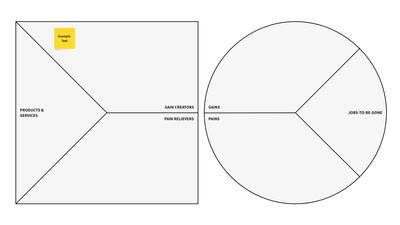- No results found.
SWOT Analysis Template
Use a SWOT analysis template for strategic planning to identify your business's strengths, weaknesses, opportunities or threats. See how to easily do it now.
Edit our SWOT analysis template to strategically plan the next steps you would like your business to take. Identify vital parameters to your company, such as strengths, weaknesses, threats, or opportunities, and use them to achieve future goals.
What is SWOT Analysis?
The SWOT analysis, also known as the SWOT matrix, is a strategic planning technique that helps businesses or individuals identify strengths, weaknesses, opportunities, or threats that are either related to a company or private projects.
In a business context, a SWOT analysis can be used by marketing or product teams, as it helps to better understand a product's strengths and weaknesses, as well as its position among competitors. However, this is not always the case.
What are the elements of SWOT?
The meaning of the SWOT analysis is in the SWOT acronym. It stands for Strengths, Weaknesses, Opportunities, and Threats. While strengths and weaknesses focus on internal factors related to the business, opportunities and threats focus on the external ones. To be able to comprehend the benefits this tool brings, it is vital to understand each of these four components.
- Strengths - a set of features that give the business an advantage over other related companies. Excellent customer service is a vital strength in any organization.
- Weaknesses - a set of features that are placing the company at a disadvantage when compared to other competitors. Lacking an essential feature can be considered a weakness.
- Opportunities - new unexplored territories the business could use to its advantage. It can refer to any business expansion that will have a positive impact on a company - from new markets to new business partners.
- Threats - external factors that could have a direct effect on a business. They can vary immensely - from economic or political factors to disrupting technological trends.

How to do a SWOT Analysis?
To make the most out of this process, all participants should have different views on the company and bring diverse perspectives to the table. As a result, anyone from the customer service department to the development team should be involved when working with a SWOT analysis template. Once you have managed to put together a team, here is what you need to know to conduct your SWOT analysis successfully:
1. Select an outside leader
To avoid biased opinions that may affect the analysis, choose someone from the outside to act as the team leader.
2. Initiate brainstorming sessions
The team can now start brainstorming ideas regarding the company's strengths. These can refer to anything from quality to team management, productivity, efficiency, internal processes, innovation, etc. At this stage, your only focus needs to be gathering as many ideas as possible. Write everything on post-its to make sure nothing is left to chance. Repeat the same process for weaknesses, threats, and opportunities.
3. Simplify and consolidate
At the end of the brainstorming session, you will be left with a multitude of ideas. Take all the post-its and place them on a wall - this way, you'll have quick access to everything that has been discussed.
Next, identify the primary subjects all ideas could fit into, and group them accordingly. Remove any duplicates and avoid adding too many concepts under one topic; otherwise, you might lose focus.
4. Ensure clarity
Before going any further, ensure all participants understand everything that has been discussed. If needed, do a quick recap for all the concepts.
5. Identify your company's top three strengths
In an ideal scenario, the top three strengths should be immediately noticeable, in which case, you've reached a consensus. However, if that is not the case, every team member should choose their top issues by vote. Once this step has been completed, you will find it easier to identify the top three strengths.
Repeat this process for the three remaining boxes in the SWOT analysis template: weaknesses, threats, and opportunities.
Benefits of using the SWOT Analysis template in Moqups
Once you have managed to use the SWOT analysis chart at its full capabilities, you will be able to tell where your business is currently positioned and where it should be. You will have gained a better understanding of the internal and external factors that can impact your organization, and will you feel inspired to deepen your analysis. It will only bring you one step closer to your objectives.
Working with a SWOT analysis template in Moqups means that both you and your team will enjoy real-time collaboration, even if you are not in the same room. You can also use a variety of features such as sticky notes, comments, and annotations, each of them vital to the optimal development of this process.




